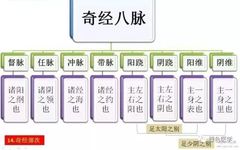
Eight Extraordinary Meridians
 The Eight Extraordinary Meridians are a category of the body’s meridian pathways. They include the Du Mai (Governing Vessel), Ren Mai (Conception Vessel), Chong Mai (Penetrating Vessel), Da Mai (Belt Vessel), Yang Wei Mai (Yang Linking Vessel), Yin Wei Mai (Yin Linking Vessel), Yin Qiao Mai (Yin Heel Vessel), and Yang Qiao Mai (Yang Heel Vessel). Unlike the twelve primary meridians, they do not directly connect to the organs and do not have a paired relationship, hence they are referred to as “extraordinary meridians.”What are the Eight Extraordinary Meridians?The Eight Extraordinary Meridians include the Ren Mai, Du Mai, Chong Mai, Da Mai, Yin Qiao Mai, Yang Qiao Mai, Yin Wei Mai, and Yang Wei Mai. They differ from the twelve primary meridians as they do not directly connect to the organs and do not have a paired relationship, thus they are called extraordinary meridians.Functions:1. Facilitate communication between the twelve meridians;2. Regulate the accumulation and distribution of Qi and blood in the twelve meridians.Eight Meridians:1. Ren Mai: Runs along the midline of the abdomen, frequently intersecting with the three Yin meridians of the hands and feet as well as the Yin Wei Mai, thus it is known as the “Sea of Yin Meridians.” The Ren Mai originates from the uterus and is related to female pregnancy, hence the saying “Ren governs the uterus.”2. Du Mai: Runs along the midline of the back, frequently intersecting with the three Yang meridians of the hands and feet as well as the Yang Wei Mai, thus it is known as the “Sea of Yang Meridians.” The Du Mai runs along the spine, ascends into the brain, and branches off from the spine to connect with the kidneys, establishing a close relationship with the brain, spinal cord, and kidneys.3. Chong Mai: Ascends to the head and descends to the feet, traversing the entire body; it serves as a crucial junction for Qi and blood, regulating the Qi and blood of the twelve meridians, hence it is called the “Sea of the Twelve Meridians” and also referred to as the “Sea of Blood.” It is related to women’s menstruation.4. Da Mai: Originates from the lateral costal region, descends obliquely to the Da Mai point, encircling the body like a belt, thus it can restrain the meridians that run vertically.5.6. Yin Qiao Mai and Yang Qiao Mai: The term “Qiao” implies agility and quickness. They are responsible for nourishing the eyes, controlling eyelid movement, and lower limb movement.7.8. Yin Wei Mai and Yang Wei Mai: The term “Wei” implies connection. The function of the Yin Wei Mai is to “connect the Yin meridians”; the function of the Yang Wei Mai is to “connect the Yang meridians.”Physiological Functions of the Eight Extraordinary Meridians1. Further strengthen the connection between the twelve meridians: For example, the Du Mai governs all Yang meridians; the Ren Mai governs all Yin meridians; the Da Mai restrains the vertical meridians. The Yin and Yang meridians govern the left and right sides of the body; the Yin Wei and Yang Wei meridians connect the interior and exterior of the body. Thus, the Eight Extraordinary Meridians further enhance the connections among various parts of the body.2. Regulate the Qi and blood of the twelve meridians: When the Qi of the twelve meridians is abundant, it is stored in the Eight Extraordinary Meridians; when the Qi and blood of the twelve meridians are insufficient, the Eight Extraordinary Meridians can “overflow” to provide timely supplementation.3. The Eight Extraordinary Meridians have a close relationship with the liver, kidneys, and other organs, as well as with the uterus, brain, and marrow, establishing certain physiological and pathological connections.
The Eight Extraordinary Meridians are a category of the body’s meridian pathways. They include the Du Mai (Governing Vessel), Ren Mai (Conception Vessel), Chong Mai (Penetrating Vessel), Da Mai (Belt Vessel), Yang Wei Mai (Yang Linking Vessel), Yin Wei Mai (Yin Linking Vessel), Yin Qiao Mai (Yin Heel Vessel), and Yang Qiao Mai (Yang Heel Vessel). Unlike the twelve primary meridians, they do not directly connect to the organs and do not have a paired relationship, hence they are referred to as “extraordinary meridians.”What are the Eight Extraordinary Meridians?The Eight Extraordinary Meridians include the Ren Mai, Du Mai, Chong Mai, Da Mai, Yin Qiao Mai, Yang Qiao Mai, Yin Wei Mai, and Yang Wei Mai. They differ from the twelve primary meridians as they do not directly connect to the organs and do not have a paired relationship, thus they are called extraordinary meridians.Functions:1. Facilitate communication between the twelve meridians;2. Regulate the accumulation and distribution of Qi and blood in the twelve meridians.Eight Meridians:1. Ren Mai: Runs along the midline of the abdomen, frequently intersecting with the three Yin meridians of the hands and feet as well as the Yin Wei Mai, thus it is known as the “Sea of Yin Meridians.” The Ren Mai originates from the uterus and is related to female pregnancy, hence the saying “Ren governs the uterus.”2. Du Mai: Runs along the midline of the back, frequently intersecting with the three Yang meridians of the hands and feet as well as the Yang Wei Mai, thus it is known as the “Sea of Yang Meridians.” The Du Mai runs along the spine, ascends into the brain, and branches off from the spine to connect with the kidneys, establishing a close relationship with the brain, spinal cord, and kidneys.3. Chong Mai: Ascends to the head and descends to the feet, traversing the entire body; it serves as a crucial junction for Qi and blood, regulating the Qi and blood of the twelve meridians, hence it is called the “Sea of the Twelve Meridians” and also referred to as the “Sea of Blood.” It is related to women’s menstruation.4. Da Mai: Originates from the lateral costal region, descends obliquely to the Da Mai point, encircling the body like a belt, thus it can restrain the meridians that run vertically.5.6. Yin Qiao Mai and Yang Qiao Mai: The term “Qiao” implies agility and quickness. They are responsible for nourishing the eyes, controlling eyelid movement, and lower limb movement.7.8. Yin Wei Mai and Yang Wei Mai: The term “Wei” implies connection. The function of the Yin Wei Mai is to “connect the Yin meridians”; the function of the Yang Wei Mai is to “connect the Yang meridians.”Physiological Functions of the Eight Extraordinary Meridians1. Further strengthen the connection between the twelve meridians: For example, the Du Mai governs all Yang meridians; the Ren Mai governs all Yin meridians; the Da Mai restrains the vertical meridians. The Yin and Yang meridians govern the left and right sides of the body; the Yin Wei and Yang Wei meridians connect the interior and exterior of the body. Thus, the Eight Extraordinary Meridians further enhance the connections among various parts of the body.2. Regulate the Qi and blood of the twelve meridians: When the Qi of the twelve meridians is abundant, it is stored in the Eight Extraordinary Meridians; when the Qi and blood of the twelve meridians are insufficient, the Eight Extraordinary Meridians can “overflow” to provide timely supplementation.3. The Eight Extraordinary Meridians have a close relationship with the liver, kidneys, and other organs, as well as with the uterus, brain, and marrow, establishing certain physiological and pathological connections.
Pathways and Physiological Functions of the Eight Extraordinary Meridians
1. Pathway and Physiological Function of the Du Mai1. Pathway: The Du Mai originates from the lower abdomen, exits at the perineum, travels posteriorly to the Changqiang point at the sacral region, ascends along the spine, passes through the nape to the Fengfu point, enters the brain, belongs to the brain, ascends along the midline of the head to the Baihui point at the crown, descends through the forehead to the Suliao point at the tip of the nose, passes through the philtrum, and reaches the Gingjiao point at the center of the upper gums.2. Branches: The first branch originates from the same point as the Chong and Ren meridians, exits at the perineum, and meets the Kidney Meridian and Bladder Meridian at the tailbone, traversing the spine and belonging to the kidneys. The second branch ascends directly from the lower abdomen through the navel, travels upward to the heart, reaches the throat, intersects with the Chong and Ren meridians, and encircles the lips, reaching the center below the lower jaw, and then travels to the center below the eyes. The third branch originates from the inner canthus of the eye, ascends to the forehead, meets at the crown, connects to the brain, and then branches off to descend along the shoulder blades and both sides of the spine, reaching the waist and entering the muscles on both sides of the spine, connecting with the kidneys.3. Physiological Functions(1) Regulates the Qi and blood of the Yang meridians, serving as the “Sea of Yang Meridians”: The Du Mai runs along the back of the body, which is Yang, indicating that the Du Mai has a commanding and supervising role over the Qi of all Yang meridians. Additionally, all six Yang meridians intersect with the Du Mai at the Dazhui point, thus the Du Mai has a regulatory effect on the Yang meridians, hence the saying “governs all Yang meridians.”(2) Reflects the functions of the brain, kidneys, and spinal cord: The Du Mai belongs to the brain and connects with the kidneys. The kidneys produce marrow, and the brain is the sea of marrow. The relationship between the Du Mai and the brain, kidneys, and spinal cord is very close.(3) Governs reproductive functions: The Du Mai connects with the kidneys, and since the kidneys govern reproduction, the Du Mai is related to reproductive functions.
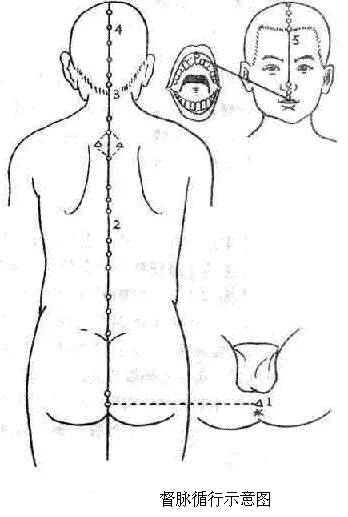 2. Pathway and Physiological Function of the Ren Mai1. Pathway: The Ren Mai originates from the uterus, exits at the perineum, travels through the Yin mound, ascends along the midline of the abdomen, passes through the throat (Tiantu point), and reaches the inner lower lip, dividing to encircle the lips, intersecting with the Du Mai at the Gingjiao point, and then separately passing through both sides of the nose, ascending to the lower eye socket (Chengqi point), and intersecting with the Yangming meridian of the foot.2. Branches: It traverses from the uterus along the spine, ascending along the back.3. Physiological Functions(1) Regulates the Qi and blood of the Yin meridians, serving as the “Sea of Yin Meridians”: The Ren Mai runs along the midline of the abdomen, which is Yin, indicating that the Ren Mai has a commanding role over the Qi of all Yin meridians. Additionally, the three Yin meridians of the foot intersect with the Ren Mai, thus the Ren Mai has a regulatory effect on the Yin meridians, hence the saying “governs all Yin meridians.”(2) Regulates menstruation and nourishes the fetus: The Ren Mai originates from the uterus, thus it has the function of regulating menstruation and promoting female reproductive functions, hence the saying “Ren governs the uterus.”
2. Pathway and Physiological Function of the Ren Mai1. Pathway: The Ren Mai originates from the uterus, exits at the perineum, travels through the Yin mound, ascends along the midline of the abdomen, passes through the throat (Tiantu point), and reaches the inner lower lip, dividing to encircle the lips, intersecting with the Du Mai at the Gingjiao point, and then separately passing through both sides of the nose, ascending to the lower eye socket (Chengqi point), and intersecting with the Yangming meridian of the foot.2. Branches: It traverses from the uterus along the spine, ascending along the back.3. Physiological Functions(1) Regulates the Qi and blood of the Yin meridians, serving as the “Sea of Yin Meridians”: The Ren Mai runs along the midline of the abdomen, which is Yin, indicating that the Ren Mai has a commanding role over the Qi of all Yin meridians. Additionally, the three Yin meridians of the foot intersect with the Ren Mai, thus the Ren Mai has a regulatory effect on the Yin meridians, hence the saying “governs all Yin meridians.”(2) Regulates menstruation and nourishes the fetus: The Ren Mai originates from the uterus, thus it has the function of regulating menstruation and promoting female reproductive functions, hence the saying “Ren governs the uterus.” 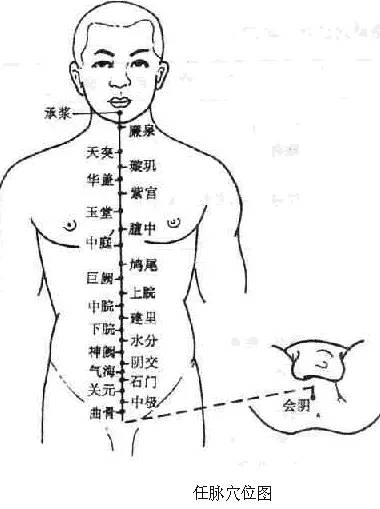
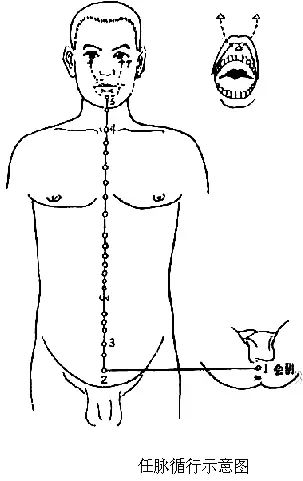 3. Pathway and Physiological Function of the Chong Mai1. Pathway: The Chong Mai originates from the uterus, exits at the perineum, and divides into two branches. The ascending branch (the main trunk of the Chong Mai) runs along the anterior abdominal wall, near the navel (five fen from the navel), ascends, intersects with the Kidney Meridian, spreads in the chest, ascends through the throat, and encircles the lips; the descending branch runs along the posterior abdominal wall, ascending within the spine. The descending branch exits the perineum and descends along the inner thigh to the space between the big toe.2. Physiological Functions(1) Regulates the Qi and blood of the twelve meridians: The Chong Mai ascends to the head and descends to the feet, traversing the entire body, serving as a crucial junction for the Qi and blood of the meridians. When the Qi and blood of the meridians and organs are abundant, the Chong Mai can store and reserve them; when they are insufficient, the Chong Mai can provide infusion and supplementation to maintain the normal physiological activities of the body’s tissues and organs. Thus, it is referred to as the “Sea of the Twelve Meridians,” “Sea of the Five Zang and Six Fu,” and “Sea of Blood.”(2) Governs reproductive functions: The Chong Mai originates from the uterus, also known as the “Blood Chamber” or “Sea of Blood.” The Chong Mai has a role in regulating menstruation. It is closely related to reproductive functions; for women, “when the Chong Mai is abundant, menstruation occurs regularly, leading to conception.” Conversely, “when the Chong Mai is deficient, menstruation ceases, and the pathways are obstructed.” Here, the “Chong Mai” refers to the Chong Mai itself. Additionally, in men, either congenital deficiency of the Chong Mai or acquired injury to the Chong Mai can lead to reproductive dysfunction.(3) Regulates the ascending and descending of Qi: The Chong Mai connects with the Kidney Meridian, belongs to the Yangming, and connects with the Jueyin and Taiyang. The Chong Mai has the function of regulating the ascending and descending of Qi in certain organs (mainly the liver, kidneys, and stomach).
3. Pathway and Physiological Function of the Chong Mai1. Pathway: The Chong Mai originates from the uterus, exits at the perineum, and divides into two branches. The ascending branch (the main trunk of the Chong Mai) runs along the anterior abdominal wall, near the navel (five fen from the navel), ascends, intersects with the Kidney Meridian, spreads in the chest, ascends through the throat, and encircles the lips; the descending branch runs along the posterior abdominal wall, ascending within the spine. The descending branch exits the perineum and descends along the inner thigh to the space between the big toe.2. Physiological Functions(1) Regulates the Qi and blood of the twelve meridians: The Chong Mai ascends to the head and descends to the feet, traversing the entire body, serving as a crucial junction for the Qi and blood of the meridians. When the Qi and blood of the meridians and organs are abundant, the Chong Mai can store and reserve them; when they are insufficient, the Chong Mai can provide infusion and supplementation to maintain the normal physiological activities of the body’s tissues and organs. Thus, it is referred to as the “Sea of the Twelve Meridians,” “Sea of the Five Zang and Six Fu,” and “Sea of Blood.”(2) Governs reproductive functions: The Chong Mai originates from the uterus, also known as the “Blood Chamber” or “Sea of Blood.” The Chong Mai has a role in regulating menstruation. It is closely related to reproductive functions; for women, “when the Chong Mai is abundant, menstruation occurs regularly, leading to conception.” Conversely, “when the Chong Mai is deficient, menstruation ceases, and the pathways are obstructed.” Here, the “Chong Mai” refers to the Chong Mai itself. Additionally, in men, either congenital deficiency of the Chong Mai or acquired injury to the Chong Mai can lead to reproductive dysfunction.(3) Regulates the ascending and descending of Qi: The Chong Mai connects with the Kidney Meridian, belongs to the Yangming, and connects with the Jueyin and Taiyang. The Chong Mai has the function of regulating the ascending and descending of Qi in certain organs (mainly the liver, kidneys, and stomach).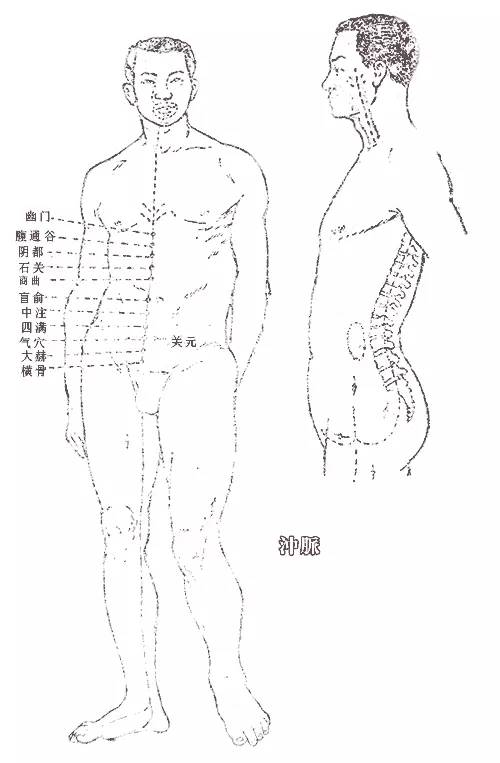 4. Pathway and Physiological Function of the Da Mai1. Pathway: The Da Mai originates from the lateral costal region, descends obliquely to the Da Mai point, encircling the body, and at the Da Mai point, it further descends obliquely along the upper edge of the hip bone to the lower abdomen.2. Physiological Functions: It restrains the vertical meridians and governs women’s leukorrhea.
4. Pathway and Physiological Function of the Da Mai1. Pathway: The Da Mai originates from the lateral costal region, descends obliquely to the Da Mai point, encircling the body, and at the Da Mai point, it further descends obliquely along the upper edge of the hip bone to the lower abdomen.2. Physiological Functions: It restrains the vertical meridians and governs women’s leukorrhea. 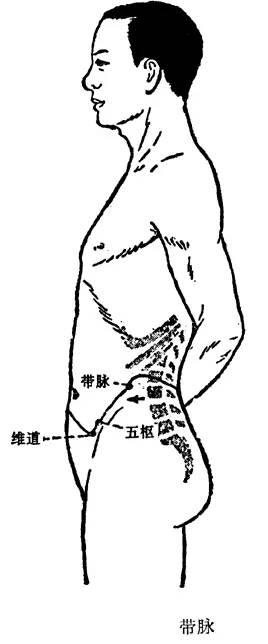 5. Pathway and Physiological Function of the Yin Qiao Mai1. Pathway: The Yin Qiao Mai originates from the inner side of the heel of the foot, from the Zhaohai point of the Kidney Meridian, ascends through the inner ankle, along the inner thigh to the anterior genital area, ascends along the anterior trunk to the chest, enters the throat near the Adam’s apple, and reaches the side of the nose, connecting with the inner canthus of the eye, and ascends along with the Taiyang and Yang Qiao Mai.2. Physiological Functions: It controls the opening and closing of the eyes and the movement of muscles.
5. Pathway and Physiological Function of the Yin Qiao Mai1. Pathway: The Yin Qiao Mai originates from the inner side of the heel of the foot, from the Zhaohai point of the Kidney Meridian, ascends through the inner ankle, along the inner thigh to the anterior genital area, ascends along the anterior trunk to the chest, enters the throat near the Adam’s apple, and reaches the side of the nose, connecting with the inner canthus of the eye, and ascends along with the Taiyang and Yang Qiao Mai.2. Physiological Functions: It controls the opening and closing of the eyes and the movement of muscles.  6. Pathway and Physiological Function of the Yang Qiao Mai1. Pathway: The Yang Qiao Mai originates from the outer side of the heel of the foot, from the Shenmai point of the Bladder Meridian, ascends along the posterior side of the outer ankle, travels upward along the outer edge of the lower limb to the abdomen. It runs along the posterior lateral side of the chest, through the shoulder, neck, and reaches the corner of the mouth, arriving at the inner canthus of the eye. It connects with the Taiyang Meridian and the Yin Qiao Mai, then ascends along the Taiyang Meridian to meet the Shaoyang Meridian at the Fengchi point behind the neck.2. Physiological Functions: It controls the opening and closing of the eyes and muscle movement.
6. Pathway and Physiological Function of the Yang Qiao Mai1. Pathway: The Yang Qiao Mai originates from the outer side of the heel of the foot, from the Shenmai point of the Bladder Meridian, ascends along the posterior side of the outer ankle, travels upward along the outer edge of the lower limb to the abdomen. It runs along the posterior lateral side of the chest, through the shoulder, neck, and reaches the corner of the mouth, arriving at the inner canthus of the eye. It connects with the Taiyang Meridian and the Yin Qiao Mai, then ascends along the Taiyang Meridian to meet the Shaoyang Meridian at the Fengchi point behind the neck.2. Physiological Functions: It controls the opening and closing of the eyes and muscle movement.  7. Pathway and Physiological Function of the Yin Wei Mai1. Pathway: The Yin Wei Mai originates from the upper five cun of the inner ankle of the foot, from the Zhuxin point of the Kidney Meridian, ascends along the inner side of the lower limb, reaches the abdomen, travels alongside the Spleen Meridian, intersects with the Liver Meridian, ascends to intersect with the Tian Tu point of the Ren Mai, and terminates at the Lian Quan point in the throat.2. Physiological Functions: The term “Wei” implies connection. The Yin Wei Mai has the function of connecting the Yin meridians.
7. Pathway and Physiological Function of the Yin Wei Mai1. Pathway: The Yin Wei Mai originates from the upper five cun of the inner ankle of the foot, from the Zhuxin point of the Kidney Meridian, ascends along the inner side of the lower limb, reaches the abdomen, travels alongside the Spleen Meridian, intersects with the Liver Meridian, ascends to intersect with the Tian Tu point of the Ren Mai, and terminates at the Lian Quan point in the throat.2. Physiological Functions: The term “Wei” implies connection. The Yin Wei Mai has the function of connecting the Yin meridians. 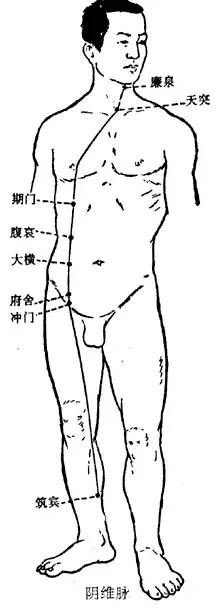 8. Pathway and Physiological Function of the Yang Wei Mai1. Pathway: The Yang Wei Mai originates from the Jinmen point of the Bladder Meridian, passes over the outer ankle, ascends along the outer edge of the lower limb, travels along the posterior lateral side of the trunk, from the back of the armpit to the shoulder, ascends through the neck, behind the ear, and moves forward to the forehead, distributing along the side of the head and back of the neck, connecting with the Du Mai.2. Physiological Functions: It connects the Yang meridians.
8. Pathway and Physiological Function of the Yang Wei Mai1. Pathway: The Yang Wei Mai originates from the Jinmen point of the Bladder Meridian, passes over the outer ankle, ascends along the outer edge of the lower limb, travels along the posterior lateral side of the trunk, from the back of the armpit to the shoulder, ascends through the neck, behind the ear, and moves forward to the forehead, distributing along the side of the head and back of the neck, connecting with the Du Mai.2. Physiological Functions: It connects the Yang meridians.
— THE END —
⊙This article is reproduced from the internet for reference only, copyright belongs to the original author. If there are any objections, please inform us for timely deletion.
⊙All prescriptions mentioned in this article should not be used blindly. This platform does not bear any responsibility for any consequences arising from this.
Recommended Reading
“Tongue Diagnosis in Traditional Chinese Medicine,” clinical high-definition tongue diagnosis images with explanations, the most comprehensive ever!


